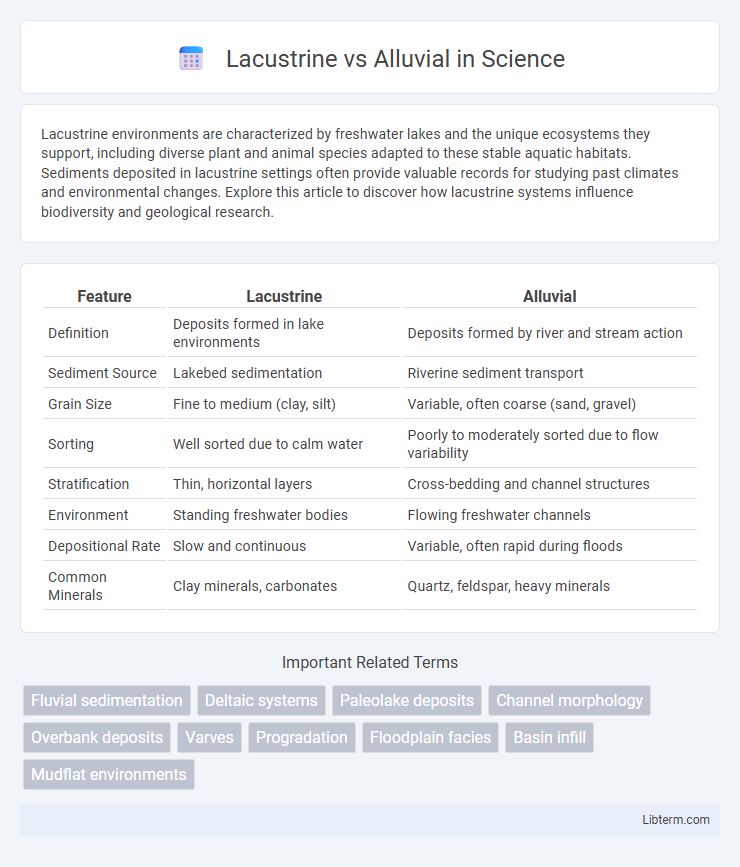Lacustrine environments are characterized by freshwater lakes and the unique ecosystems they support, including diverse plant and animal species adapted to these stable aquatic habitats. Sediments deposited in lacustrine settings often provide valuable records for studying past climates and environmental changes. Explore this article to discover how lacustrine systems influence biodiversity and geological research.
Table of Comparison
| Feature | Lacustrine | Alluvial |
|---|---|---|
| Definition | Deposits formed in lake environments | Deposits formed by river and stream action |
| Sediment Source | Lakebed sedimentation | Riverine sediment transport |
| Grain Size | Fine to medium (clay, silt) | Variable, often coarse (sand, gravel) |
| Sorting | Well sorted due to calm water | Poorly to moderately sorted due to flow variability |
| Stratification | Thin, horizontal layers | Cross-bedding and channel structures |
| Environment | Standing freshwater bodies | Flowing freshwater channels |
| Depositional Rate | Slow and continuous | Variable, often rapid during floods |
| Common Minerals | Clay minerals, carbonates | Quartz, feldspar, heavy minerals |
Introduction to Lacustrine and Alluvial Environments
Lacustrine environments form in lake settings characterized by fine-grained sediments such as silts and clays, often accumulating in calm waters with limited energy. Alluvial environments occur in river and floodplain systems, where sediments like sand, gravel, and silt are deposited through fluvial processes resulting from varying flow velocities. Understanding the distinct depositional patterns and sediment compositions of lacustrine and alluvial environments is essential for interpreting past geological and ecological conditions.
Defining Lacustrine Deposits
Lacustrine deposits form in lake environments where fine-grained sediments like clays, silts, and organic materials accumulate in calm, still water conditions, often creating well-layered strata. These deposits are characterized by high preservation potential of fossils and organic matter due to low oxygen levels and slow sedimentation rates. In contrast, alluvial deposits result from river and stream activities, featuring coarser, more heterogeneous sediments such as sands, gravels, and silts transported and sorted by flowing water.
Characteristics of Alluvial Systems
Alluvial systems are characterized by sediment deposits transported and deposited by flowing water, typically found in riverbeds, floodplains, and deltas. These deposits consist mainly of sand, silt, clay, and gravel, exhibiting well-sorted layers due to continuous water movement. The dynamic nature of alluvial systems supports fertile soils, high permeability, and frequent sediment reworking, distinguishing them from lacustrine environments that form in lake basins with finer, more stable sediment accumulation.
Formation Processes: Lacustrine vs Alluvial
Lacustrine formations develop from sediment accumulation in lake environments, characterized by fine-grained silts and clays that settle in calm water. Alluvial deposits originate from rivers and streams, consisting mainly of coarser materials like sands and gravels transported and deposited by flowing water. These contrasting sedimentation processes result in distinct textures and stratification patterns, reflecting their depositional environments.
Sediment Types and Grain Size Distribution
Lacustrine sediments typically consist of fine-grained particles such as clays and silts, deposited in calm lake environments, resulting in well-sorted layers with uniform grain size distribution. Alluvial sediments are more heterogeneous, containing a mix of grain sizes ranging from coarse sands to gravels, due to fluctuating water flow in river channels and floodplains. The sediment sorting in alluvial deposits tends to be poor compared to lacustrine sediments, reflecting dynamic depositional processes.
Stratigraphy Differences Between Lacustrine and Alluvial
Lacustrine stratigraphy is characterized by fine-grained sediments such as clays and silts deposited in low-energy lake environments, often exhibiting well-preserved varves and distinct seasonal layering. In contrast, alluvial stratigraphy comprises coarser sediments like sands and gravels, reflecting high-energy fluvial processes with channel fills, cross-bedding, and rapidly changing facies. These differences highlight lacustrine deposits as typically more homogeneous and finely laminated, whereas alluvial sequences display heterogeneity and complex stratification patterns due to fluctuating water flow.
Geographical Occurrence and Examples
Lacustrine deposits form in lake environments, typically found in tectonic basins and glacial valleys, with prominent examples including the sediments of the Great Lakes in North America and the Dead Sea basin in the Middle East. Alluvial deposits develop in river and floodplain systems, commonly occurring along active river channels and delta regions, exemplified by the Mississippi River alluvial plains and the Indo-Gangetic Plain in South Asia. Geographically, lacustrine settings are characterized by relatively still water bodies leading to fine-grained sediment accumulation, whereas alluvial settings involve dynamic fluvial processes resulting in heterogeneous sediment layers.
Importance in Paleoenvironments and Fossil Records
Lacustrine deposits, formed in lake environments, provide critical paleoenvironments for preserving finely layered sedimentary records and well-preserved fossils, allowing detailed reconstructions of past climate and ecosystems. Alluvial deposits, created by river and floodplain processes, reveal dynamic environmental changes through varied sediment textures and fossil assemblages, reflecting terrestrial habitats and biotic adaptations. Both depositional settings are essential for understanding sedimentary processes, paleoecology, and evolutionary patterns in Earth's history.
Economic and Environmental Significance
Lacustrine deposits, formed in lake environments, are often rich in fine-grained sediments and organic materials, making them valuable for hydrocarbon extraction and groundwater aquifers. Alluvial deposits, created by river action, frequently contain fertile soils essential for agriculture and host economically significant mineral resources like gold and diamonds. Environmentally, lacustrine systems support diverse ecosystems and act as natural carbon sinks, while alluvial plains influence flood control and habitat connectivity, impacting biodiversity and land management strategies.
Conclusion: Key Distinctions Between Lacustrine and Alluvial Deposits
Lacustrine deposits form in lake environments characterized by fine-grained sediments like clays and silts, often preserving organic materials and fossils, while alluvial deposits accumulate from river and stream actions, featuring coarser materials such as sands and gravels sorted by water flow. Lacustrine sediments typically indicate relatively still water conditions with stratified layering, contrasting with the more dynamic, heterogeneous sediment patterns in alluvial settings. Understanding these differences is crucial for interpreting past environmental conditions, sedimentary processes, and potential resource locations like groundwater reservoirs or hydrocarbon sources.
Lacustrine Infographic

 libterm.com
libterm.com